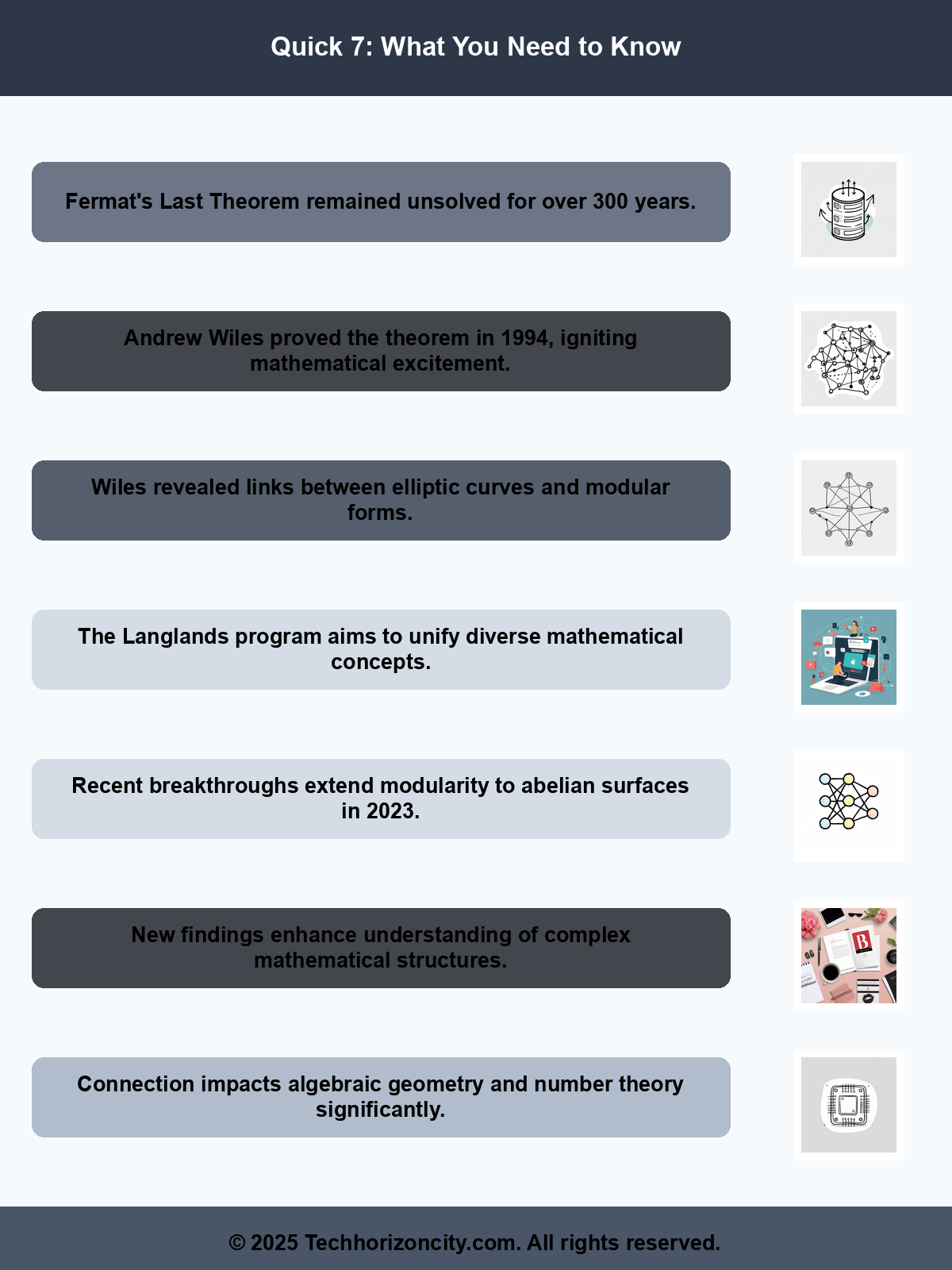Executive Summary
The realm of mathematics is vast and intricate, often resembling an elaborate tapestry woven over centuries. Among the most profound threads in this tapestry is the journey from Fermat’s Last Theorem, which baffled mathematicians for over three hundred years, to the recent groundbreaking developments in modularity. In 1994, Andrew Wiles’ proof of Fermat’s theorem not only resolved a historical enigma but also unveiled an elegant connection between elliptic curves and modular forms. Fast forward to February 2023, a new milestone has been achieved with the extension of this modularity connection to abelian surfaces by a dedicated team of mathematicians. This article explores the implications of these advancements and their potential to reshape the mathematical landscape.

Background Context
Fermat’s Last Theorem, posited by Pierre de Fermat in 1637, claimed that there are no three positive integers \(a\), \(b\), and \(c\) that satisfy the equation \(a^n + b^n = c^n\) for any integer \(n > 2\). This assertion remained unproven until Andrew Wiles, a British mathematician, made history with his proof in 1994, igniting a wave of excitement and reverence in the mathematical community. Wiles’ work illuminated an unexpected linkage between elliptic curves—equations whose graphical representations form a doughnut shape—and modular forms, which are complex functions exhibiting symmetry.
This newfound relationship was pivotal, leading to the broader Langlands program, a visionary framework that aims to unify various mathematical concepts by correlating different equations with modular forms. The implications of this program stretch well beyond Fermat’s Last Theorem, serving as a foundation for addressing a plethora of mathematical challenges, including those rooted in number theory and algebraic geometry.
For technical resources and innovative solutions, please visit EchoesOfCreationUS for specialized technical resources.
Analysis of Implications
The recent extension of Wiles’ modularity connection to abelian surfaces represents a significant leap in the field. Conducted by Frank Calegari, George Boxer, Toby Gee, and Vincent Pilloni, this proof not only validates the conjectures associated with the Langlands program but also proposes that every abelian surface within a specific class can be aligned with a modular form. Over nearly a decade of meticulous work, these mathematicians have opened new avenues for understanding complex mathematical structures, thereby offering a fresh lens through which to view longstanding problems.
This development carries multifaceted implications. By establishing this connection, we gain a deeper understanding of abelian surfaces—a class of geometric objects that play a crucial role in various areas of mathematics, from algebraic geometry to number theory. Their relationship with modular forms could potentially lead to unexpected applications across different mathematical domains, including cryptography, coding theory, and beyond. It also paves the way for new research, inviting mathematicians to explore the boundaries of what is known and what remains to be discovered.
Industry Impact Assessment
The intersection of mathematics and modern technology cannot be overstated. As mathematical theories evolve, they often find surprising applications in fields such as computer science, economics, and engineering. The modularity connection, now extending to abelian surfaces, stands to influence not just theoretical mathematics, but also practical applications in various industries.
For instance, cryptography relies heavily on number theory and properties of elliptic curves. As researchers gain a richer understanding of abelian surfaces and their modular counterparts, we may see advancements in secure communication protocols and algorithms. Additionally, industries that utilize complex algorithms for data encryption may benefit from the novel mathematical insights generated by this research, leading to enhanced security measures.
Moreover, as this work garners more attention, it could inspire new educational initiatives, fostering a new generation of mathematicians to engage with cutting-edge concepts. The excitement expressed by figures like Ana Caraiani, who heralded the realization of these conjectures, encapsulates a growing enthusiasm for mathematical exploration that could invigorate academia and industry alike.
Discover exclusive offers and premium content at Active Living Offers – your gateway to enhanced productivity and lifestyle solutions.
Future Outlook
The future of mathematics in light of the recent advancements surrounding modular forms and abelian surfaces is teeming with potential. As researchers continue to investigate the implications of Wiles’ proof and its extensions, we can anticipate several trends. First, the ongoing pursuit of the Langlands program will likely yield further revelations, as mathematicians work to refine and expand the connections between seemingly disparate areas of mathematics.
Second, the collaborative nature of modern mathematical research will likely intensify. The complexity of the problems at hand necessitates interdisciplinary cooperation, drawing insights from various branches of mathematics and even adjacent fields. This collaborative spirit could catalyze new discoveries that surpass the boundaries of conventional mathematics.
Lastly, as the mathematical community embraces these advancements, we may witness a renaissance in the public perception of mathematics itself. The narrative surrounding Fermat’s Last Theorem and its resolution has already captivated many, and the unfolding story of modularity promises to inspire curiosity and engagement, potentially leading to increased investment in mathematical research and education.
Conclusion with Key Takeaways
In conclusion, the journey from Fermat’s Last Theorem to the recent breakthroughs in modularity exemplifies the dynamic and ever-evolving nature of mathematics. The efforts of Andrew Wiles paved the way for a broader understanding of mathematical relationships, and the recent work by Calegari, Boxer, Gee, and Pilloni marks a significant milestone in this ongoing exploration. As we stand on the cusp of new mathematical frontiers, the implications for both theoretical understanding and practical applications are profound.
Key takeaways from these developments include:
- The proof of Fermat’s Last Theorem has far-reaching implications beyond its initial solution.
- Establishing connections among different mathematical structures can lead to breakthroughs in understanding complex concepts.
- Interdisciplinary collaboration will be essential for future discoveries.
- The excitement surrounding these advancements may bolster public interest in mathematics, encouraging a new generation of mathematicians.
Disclaimer: This article was independently created based on publicly available information and industry analysis.
